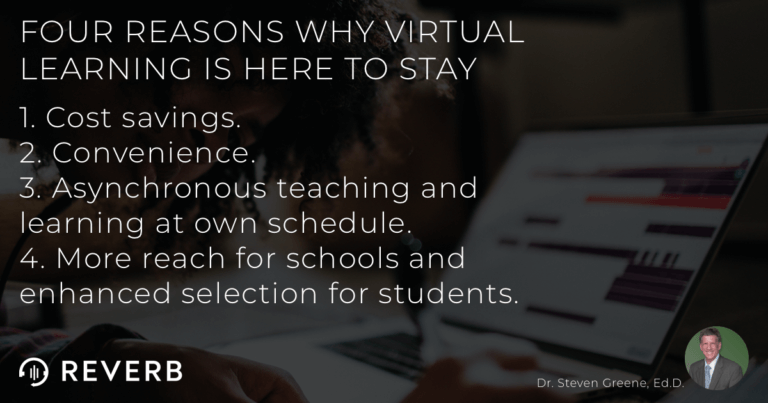The author’s views are entirely his or her own and may not always reflect the views of Reverb.
Virtual learning is here to stay. Though COVID-19 has considerably accelerated the rollout of virtual / distance learning, the off-site learning option has existed for some time and will continue to expand in the near and long term.
Here’s why.
The reasons
In the Spring of this year, all elementary, middle, and high schools, and universities were required to transition to distance learning. Of course, this was due to social distancing necessities, and it forced the adoption of virtual learning on a mass level.
While initially unfavorable, these requirements have been revealing benefits that will lead to the longevity of remote and blended learning.
Distance learning comes with enormous cost savings as there’s less physical structure needed.
There’s more convenience, both for instructors and students at all levels.
Instructors can create and deliver content asynchronously, meaning there’s both more freedom for teachers and students. Students can learn at their own schedule, and teachers can teach on theirs.
With asynchronous teaching comes a broader student and instructional base. Schools are not limited to only the students in the classroom and can sell coursework nationally or internationally.
All of this combines to make virtual learning an extremely appealing option and alternative to the traditional classroom.
At my educational support company, as late as March 13th, just before the COVID-19 outbreak, about 65% of our students were served in-house at our facility, and 35% were online. By April 1st, 100% had transitioned online using our distance learning technology.
One-on-one works very well
In a one-on-one setting, virtual / distance learning and tutoring are very effective. Students are given the attention and teaching protocol that works best for them to succeed.
Virtual education on a large classroom level, particularly with a highly heterogeneous population of students, is more challenging, and some disadvantages are well-publicized.
There’s less instructor to student interaction, more obstacles for students to receive answers to questions or support, and technology challenges. Not everyone has access to high-speed internet or sufficient technology to host online learning.
There’s also increased difficulty policing online cheating and giving fair exams. Students taking exams and assessments remotely lack the security and oversight that would occur in a classroom, so cheating and other dishonest practices are more common.
The good outweighs the bad
Even so, for most situations, the positive characteristics of virtual learning outweigh the downsides.
As students, training and instructional centers, and academic institutions become more accustomed to distance protocols and standards, the implementation of proper virtual learning will increase and continue to grow. Technology will also improve over time, fixing the current downsides, and building a larger and larger segment of this instructional methodology.






